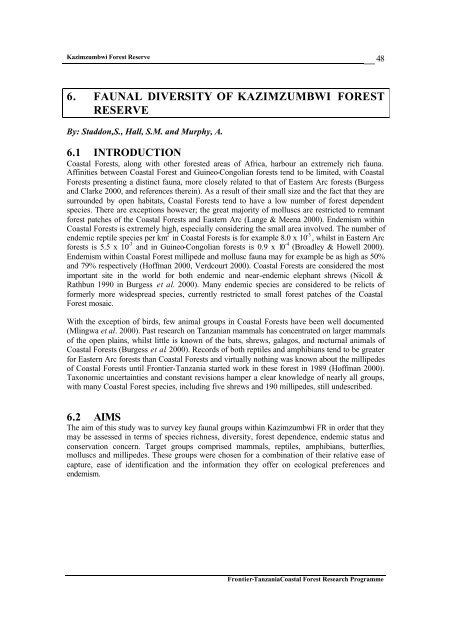Frontier Tanzania Environmental Research REPORT 110 ...
Frontier Tanzania Environmental Research REPORT 110 ...
Frontier Tanzania Environmental Research REPORT 110 ...
Create successful ePaper yourself
Turn your PDF publications into a flip-book with our unique Google optimized e-Paper software.
Kazimzumbwi Forest Reserve<br />
48<br />
6. FAUNAL DIVERSITY OF KAZIMZUMBWI FOREST<br />
RESERVE<br />
By: Staddon,S., Hall, S.M. and Murphy, A.<br />
6.1 INTRODUCTION<br />
Coastal Forests, along with other forested areas of Africa, harbour an extremely rich fauna.<br />
Affinities between Coastal Forest and Guineo-Congolian forests tend to be limited, with Coastal<br />
Forests presenting a distinct fauna, more closely related to that of Eastern Arc forests (Burgess<br />
and Clarke 2000, and references therein). As a result of their small size and the fact that they are<br />
surrounded by open habitats, Coastal Forests tend to have a low number of forest dependent<br />
species. There are exceptions however; the great majority of molluscs are restricted to remnant<br />
forest patches of the Coastal Forests and Eastern Arc (Lange & Meena 2000). Endemism within<br />
Coastal Forests is extremely high, especially considering the small area involved. The number of<br />
endemic reptile species per km 2 in Coastal Forests is for example 8.0 x 10 -3 , whilst in Eastern Arc<br />
forests is 5.5 x 10 -3 and in Guineo-Congolian forests is 0.9 x 10 -4 (Broadley & Howell 2000).<br />
Endemism within Coastal Forest millipede and mollusc fauna may for example be as high as 50%<br />
and 79% respectively (Hoffman 2000, Verdcourt 2000). Coastal Forests are considered the most<br />
important site in the world for both endemic and near-endemic elephant shrews (Nicoll &<br />
Rathbun 1990 in Burgess et al. 2000). Many endemic species are considered to be relicts of<br />
formerly more widespread species, currently restricted to small forest patches of the Coastal<br />
Forest mosaic.<br />
With the exception of birds, few animal groups in Coastal Forests have been well documented<br />
(Mlingwa et al. 2000). Past research on <strong>Tanzania</strong>n mammals has concentrated on larger mammals<br />
of the open plains, whilst little is known of the bats, shrews, galagos, and nocturnal animals of<br />
Coastal Forests (Burgess et al. 2000). Records of both reptiles and amphibians tend to be greater<br />
for Eastern Arc forests than Coastal Forests and virtually nothing was known about the millipedes<br />
of Coastal Forests until <strong>Frontier</strong>-<strong>Tanzania</strong> started work in these forest in 1989 (Hoffman 2000).<br />
Taxonomic uncertainties and constant revisions hamper a clear knowledge of nearly all groups,<br />
with many Coastal Forest species, including five shrews and 190 millipedes, still undescribed.<br />
6.2 AIMS<br />
The aim of this study was to survey key faunal groups within Kazimzumbwi FR in order that they<br />
may be assessed in terms of species richness, diversity, forest dependence, endemic status and<br />
conservation concern. Target groups comprised mammals, reptiles, amphibians, butterflies,<br />
molluscs and millipedes. These groups were chosen for a combination of their relative ease of<br />
capture, ease of identification and the information they offer on ecological preferences and<br />
endemism.<br />
<strong>Frontier</strong>-<strong>Tanzania</strong>Coastal Forest <strong>Research</strong> Programme

















